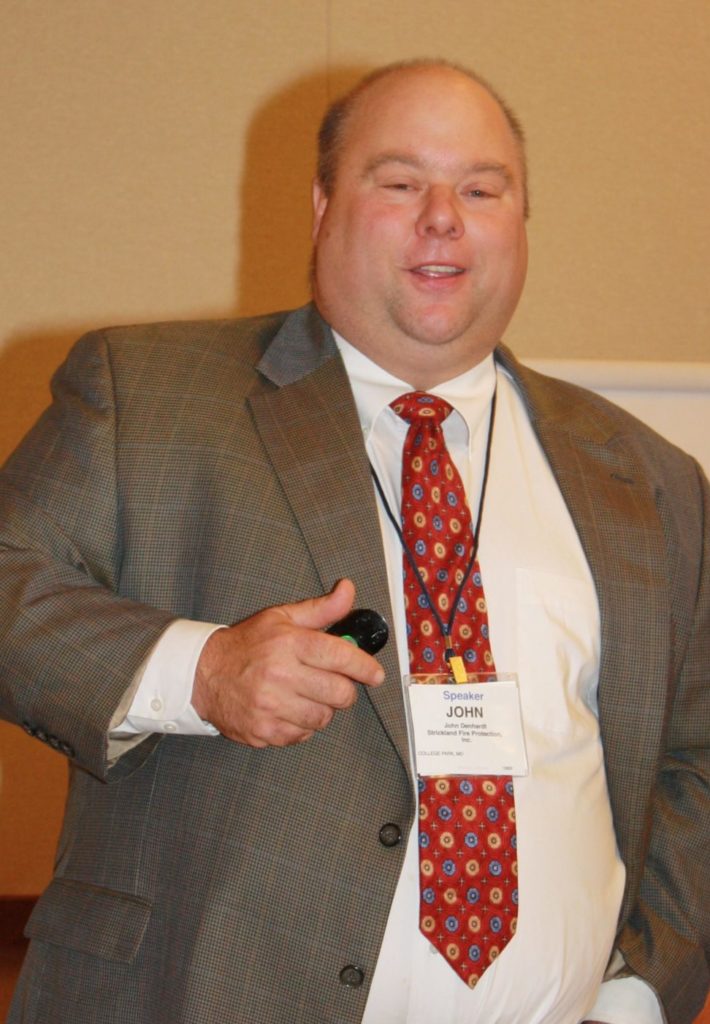The process of creating the 2022 edition of NFPA 13, Standard for the Installation of Sprinkler Systems, is winding down. Public inputs, public comments, technical committee meetings and discussions, and the voting process have been completed. Overall, the AFSA technical services staff is satisfied with the results. However, there is one technical item the team feels needs to be addressed before the 2022 edition is approved for release for use. The purpose of this column is to describe the NFPA process that needs to be followed to challenge this issue and briefly describe the concern with the current language. In the May/June 2021 issue of Sprinkler Age, I will describe the technical issue in detail, explain why we feel this issue needs to be changed, and the process we will need our members to assist.
At this point, AFSA’s technical service staff has filed a Notice of Intent to Make a Motion (NITMAM). A NITMAM is a proposed amending motion for NFPA membership consideration and debate at the NFPA Technical Meeting. These motions are attempts to amend the Technical Committee’s recommended text published as the Second Draft. Once filed, the Motions Committee reviews all notices and certifies those deemed proper, in accordance with the NFPA regulations. The Motions Committee can also, in consultation with the submitter of the motion, clarify the intent of each motion and combine motions that are dependent upon one another so that they can be made in one single motion at the NFPA Technical Meeting. The Motions Committee report is published in advance of the NFPA Technical Meeting and contains all Certified Amending Motions (CAMs). Only CAMs and any proper follow-up motions are permitted at the NFPA Technical Meeting. A NITMAM can only be filed by an individual who meets very specific conditions. In this case, I met the required conditions, and we expect the NITMAM to become a CAM. We are aware of at least two other NITMAMs which have been filed on this technical issue. We believe if all of these motions become CAMs, all three will be combined for one single CAM.
Since COVID-19 concerns have once again impacted the NFPA annual meeting, the discussions, arguments, and voting on the CAMs will be handled virtually. This process was utilized last year, and while the process was completed, NFPA experienced and learned from some issues with the process. At the time of the writing of this column, NFPA has not released the exact process which will be followed this year.
I would request all readers of my column review the current (2019 edition) and proposed (2022) language of NFPA 13. Specifically, section 5.2.2.2 in the 2019 edition states, “5.2.2.2* The volume and pressure of a public water supply shall be determined from waterflow test data or other approved method.”
The annex section A.5.2.2.2. states, “An adjustment to the waterflow test data to account for daily and seasonal fluctuations, possible interruption by flood or ice conditions, large simultaneous industrial use, future demand on the water supply system, or any other condition that could affect the water supply should be made as appropriate.”
For the 2022 edition of NFPA 13, these sections have undergone major changes. I am stating the language as currently proposed:
“5.2.2.2.2*
Where a waterflow test is conducted to provide water supply information, the raw data from the test shall be evaluated to determine if an adjustment is appropriate.
A.5.2.2.2.2
The evaluation can be based on information from the water supply authority, testing, modeling, the fire or building department, or knowledge of the water supply from having worked in the jurisdiction. Depending on how much the pressure changes over time at any given location, an adjustment might or might not be appropriate. For mature water supplies (i.e., ones where new development in the vicinity is unlikely due to the fact that available property has already been fully developed) with fairly stable water usage, or where the waterflow test is conducted at a time of low pressure already, a very small adjustment or no adjustment at all might be appropriate. In an instance where the waterflow test is performed at a time of low demand when it is known that higher demands occur at other times of the day or the year, then a larger adjustment would be appropriate.
5.2.2.2.2.1*
The evaluation shall be based on knowledge of the water supply and engineering judgment and shall consider daily and seasonal fluctuations, not extreme conditions.
A.5.2.2.2.2.1
The evaluation to determine whether an adjustment should be made and the size of such an adjustment should consider the following variables, applicable to different degrees depending on how and when the test was conducted:
1. Maximum daily use of the water supply
2. Peak hour demand of the water supply
3. Water supply degradation due to planned development
4. Time of day the test was conducted
5. Time of year the test was conducted
6. Elevation of the test location compared to the building where the sprinkler system will be installed
7. Elevation of the water supply at the time of the test
8. How close the flow generated during the test was to the system demand
There is no single specific adjustment applied to a water supply that would be appropriate for every sprinkler system. The design professional needs to work in conjunction with the authority having jurisdiction to determine the appropriate adjustment. Where an authority having jurisdiction has already determined a specific buffer between test results and the demand of the sprinkler system, it is not the intent of this standard to add an additional safety factor or safety margin; the buffer mandated by the authority having jurisdiction serves the purpose of the adjustment.
In the absence of information from the design professional and the authority having jurisdiction, it would be appropriate to make an adjustment to the raw data from a flow test by either obtaining information from the water utility or using a reasonable adjustment. Such an adjustment should be determined through a conversation with the authority having jurisdiction.
It is important to note that not all water supplies have a linear relationship of flow to pressure. As flow demand increases, additional water can be provided into the system through multiple pumps, causing complex geometries to the pressure and flow relationship at any given point in the system. Creating multiple flow conditions during a test and getting as close as possible to the sprinkler system demand will assist in gaining a complete understanding of the water supply.
5.2.2.2.2.2
If an adjustment is determined to be appropriate, it shall be applied to the waterflow test data prior to comparison with the sprinkler system demand.
5.2.2.2.2.3
Where the water supply information is obtained from another approved method other than a waterflow test, that method shall consider daily and seasonal fluctuations, not extreme conditions.”
As I stated earlier, I will discuss the technical issues and potential liability issues we see with the new language in the May/June edition of Sprinkler Age. We will need the members of AFSA to make the voices known to NFPA on this issue. AFSA will let you know how to make your voices heard. I appreciate your effort on this issue.

ABOUT THE AUTHOR: John August Denhardt, P.E., FSFPE, is vice president of engineering & technical services for the American Fire Sprinkler Association (AFSA). Shown here at AFSA30 in 2011 in San Antonio.
 Sprinkler Age A Publication of the American Fire Sprinkler Association
Sprinkler Age A Publication of the American Fire Sprinkler Association
